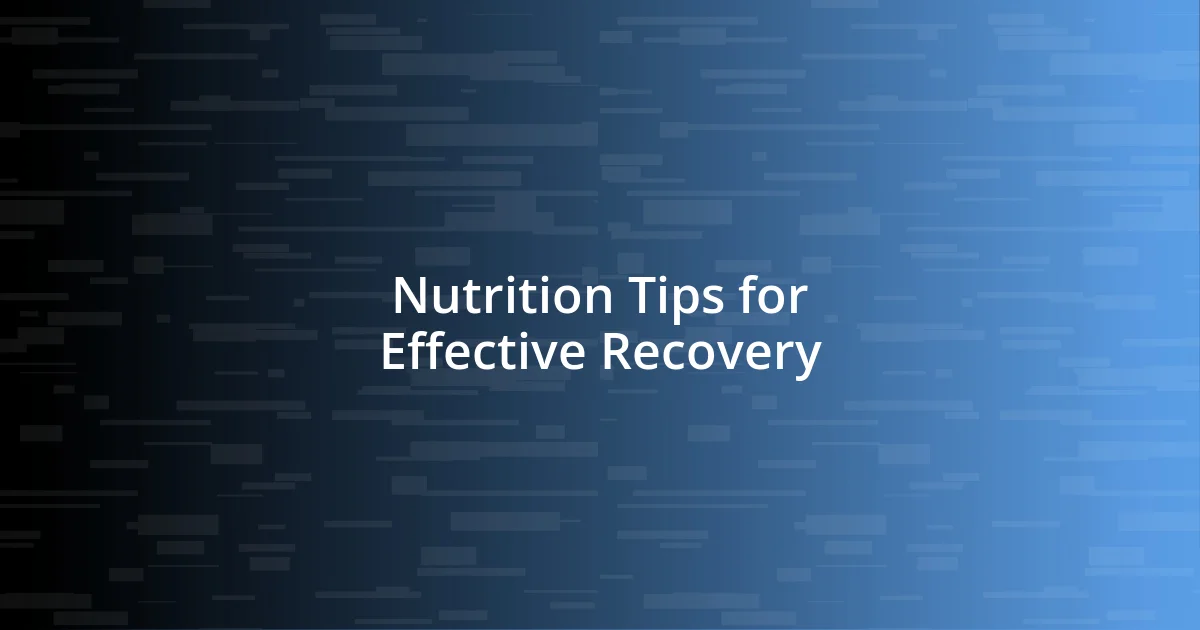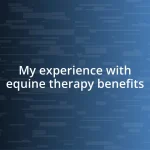Key takeaways:
- Post-ride recovery, including proper hydration, nutrition, and stretching, is essential for enhancing performance and preventing burnout.
- Maintaining a balanced diet with carbohydrates, proteins, and healthy fats, ideally consumed within 30-60 minutes post-ride, is crucial for muscle recovery.
- Incorporating mental recovery practices like mindfulness, journaling, and visualization strengthens overall recovery and prepares the mind for future rides.

Importance of Post-Ride Recovery
Post-ride recovery is crucial for anyone who wants to push their limits while ensuring their body remains in top shape. I remember a time when I neglected this part of my routine; I powered through feeling sore, thinking it made me tougher. In retrospect, that decision cost me weeks of training—and trust me, the frustration was real.
Taking time to cool down and refuel after a ride is not just about preventing soreness. It’s also about enhancing performance for your next adventure. I often find myself reflecting on the rides where I didn’t prioritize recovery—socially, physically, and mentally, I felt off my game. When I invest those extra minutes in stretching or hydrating, I can feel the difference the next day. Isn’t it amazing how a little self-care can extend your enjoyment of cycling?
Moreover, proper recovery can lead to better muscle adaptation and increased stamina. When I first started cycling, I would wake up the next day completely drained and struggling to get back on the bike. I now understand that allowing my muscles to repair and rebuild can transform my overall ride experience. How great would it be to look forward to each ride, knowing I’m treating my body right in between?

Hydration Strategies After Riding
Hydration is a vital part of my post-ride recovery routine. I learned this the hard way during a long summer ride when I assumed water alone would suffice. By the end, I felt light-headed and fatigued, a clear signal that I had overlooked my electrolyte balance. Now, I make it a point to incorporate both water and an electrolyte drink; it’s like having a safety net that ensures I bounce back quickly.
Here are some hydration strategies that I rely on after riding:
- Start Early: I begin rehydrating as soon as I get off the bike. I’ve noticed that doing so helps alleviate fatigue faster.
- Mix It Up: I alternate between plain water and electrolyte drinks. Having a variety keeps me motivated to stay hydrated.
- Fruit Power: I enjoy snacking on hydrating fruits like watermelon or oranges, which not only replenish fluids but also satisfy my sweet tooth.
- Track Intake: I keep a water bottle handy and set goals for how much to drink. It’s a simple visual reminder, and I find it keeps me accountable.
- Post-Ride Routine: I’ve adopted a specific hydration ritual—incorporating a drink into my stretching routine. This dual focus makes recovery feel more intentional.
Every ride is an opportunity to listen to my body, and paying attention to hydration has truly changed my post-ride recovery game. I feel energized and ready to tackle the next day’s adventures, and honestly, it’s a joy to feel like I’m taking care of myself.

Nutrition Tips for Effective Recovery
Nutrition plays a vital role in my post-ride recovery process. I remember one particularly grueling ride where I skipped my usual recovery meal, thinking I could power through on snacks alone. The result? I felt drained, sluggish, and not my best self for days. Now, I prioritize a balanced meal containing carbohydrates, protein, and healthy fats. For instance, a smoothie with banana, spinach, and protein powder has become my go-to. It’s amazing how fueling my body properly makes me feel revitalized and eager for the next ride.
Timing is everything when it comes to nutrition after riding. Research shows that consuming protein and carbs within 30 to 60 minutes post-ride helps muscle recovery significantly. I’ve made it a habit to prepare recovery meals ahead of time, so I never miss that window. Whether it’s a hearty quinoa salad or a yogurt with granola, having something ready means I can refuel quickly and efficiently. I can’t stress enough how this habit has transformed my energy levels for the days ahead, allowing me to chase new challenges on the bike.
I like to get creative with my recovery snacks too. One of my favorites is avocado toast topped with a poached egg. This meal not only replenishes my body but also feels like a treat. The creaminess of the avocado paired with the richness of the egg hits the spot after a tough ride. I enjoy experimenting, and it’s satisfying to discover new combinations that work for my recovery. Fueling my body doesn’t just feel good; it also becomes an experience I look forward to after every adventure!
| Food Type | Benefits |
|---|---|
| Banana | Rich in potassium; helps prevent cramps |
| Greek Yogurt | High in protein; aids muscle repair |
| Quinoa | Complete protein; provides sustained energy |
| Nut Butter | Healthy fats; promotes satiety |

Stretching Techniques for Muscle Relief
Stretching is such a vital part of my muscle recovery after a ride. I remember one particularly tough climb that left my legs feeling like lead. That’s when I discovered the magic of focused stretching. Simple techniques, like holding a standing quadriceps stretch for 30 seconds, have not only provided immediate relief but also helped prevent stiffness over the following days. Have you ever felt that sweet release of tension right after a good stretch? It’s as if my muscles are thanking me.
I also love incorporating dynamic stretches into my routine, like leg swings and hip circles. They’re not just useful for warming up; they’ve been instrumental in my cooldown process. I vividly recall a ride where I neglected this step, and the next morning, I could barely move. Now, I can’t imagine skipping them. Doing these movements feels like giving my body the attention it craves, and I walk away feeling limber and rejuvenated.
When it comes to post-ride stretching, I can’t stress enough how restorative it can be—especially when paired with deep breathing. Each inhale fills me with fresh energy, while each exhale allows me to release any lingering tension. One of my favorite stretches is the seated forward bend. As I reach for my toes, I can literally feel the tightness melting away. Does it sound too simplistic? Well, it’s profoundly effective for me, and I think you might find it equally satisfying. Engaging in these techniques has transformed my recovery experience, turning it into a cherished ritual rather than just a chore.

Rest and Sleep for Recovery
Rest and sleep are crucial components of my recovery routine after a long ride. I’ve come to realize just how deeply restful sleep impacts my overall performance. There have been days when I skimped on sleep, thinking I could catch up later, but let me tell you, waking up tired makes every climb feel steeper and every mile seem longer. Have you ever felt the weight of fatigue dragging you down? I know I have, and that’s why I now prioritize getting at least 7-8 hours of quality sleep after intense rides.
I find that creating a calming pre-sleep ritual significantly improves my rest. This might include winding down with a book, dimming the lights, or even a few light stretches. These small habits signal my body that it’s time to recover. I vividly remember a night when I skipped this routine and ended up tossing and turning. I woke up feeling far from refreshed, which made the next day on my bike more challenging than it had to be. Have you ever experienced that frustrating cycle of sleeplessness? It can be tough, but crafting a soothing environment transforms the quality of my rest.
Interestingly, I’ve also discovered that napping can provide an extra boost. A quick 20-30 minute snooze after a ride does wonders for revitalizing my energy levels. I once had a midday ride where I felt my energy flagging, so I nestled in for a short nap and woke up feeling renewed. It’s remarkable how just a bit of rest can recharge my entire system. Naps are like secret weapons in my recovery arsenal. Have you found what works for you in terms of rest? It’s all about figuring out what resonates with your body and makes your recovery more effective.

Mental Recovery Practices
After an intense ride, I’ve found that incorporating mindfulness techniques truly enhances my mental recovery. When I take a moment to reflect on my ride—what I loved, the challenges I faced, and even the moments of pure joy—I feel a profound sense of satisfaction. It’s almost like giving my mind a mini debriefing session. Have you ever talked through your experiences after a workout? Sharing those highs and lows has helped me appreciate all aspects of my cycling journey.
Journaling has also become a cherished practice. I dedicate a few minutes to writing down my thoughts and feelings about the ride, be it my triumphs or areas I want to improve. I remember one time, after a particularly grueling ascent, I wrote about my determination and resilience. As I put pen to paper, I could feel my mental barriers dissolving, and with each word, I learned more about myself. Do you keep a journal? It can be an eye-opening way to track progress and celebrate personal growth.
Finally, I can’t overstate the power of visualizing my next ride during recovery. I often close my eyes and picture the road, my bike fluidly gliding along the path ahead. This simple technique recharges my motivation and reinforces a positive mindset. I’ll admit, at first, it felt a bit strange—like daydreaming—but I now see it as a personal strategy for mental strength. Have you explored visualization? It’s like training my mind to be just as prepared as my body, and that connection makes my rides even more enjoyable.

Monitoring Progress and Adjustments
Monitoring my progress post-ride has been an enlightening journey. Initially, I tossed numbers around without much thought—heart rate, mileage, and time. But I learned that tracking meaningful metrics, like how I felt during different segments of my ride, is what truly matters. Have you ever noticed how sometimes your body’s response doesn’t match the data? I recall a ride where my stats looked great, but I felt drained. Acknowledging those feelings helped me adjust my training plan for better alignment with my body’s signals.
With time, I’ve developed a more intuitive approach to make necessary adjustments. For example, after a particularly demanding week, I noticed signs of fatigue creeping in that I couldn’t ignore. Instead of pushing through, I dialed back my intensity and incorporated more recovery rides. It was a tough decision at first; I worried I was losing my edge. Have you faced similar dilemmas? I realized that listening to my body prevented burnout and ultimately enhanced my performance.
I also find value in maintaining a detailed record of my rides, including my emotional state and how well I recovered. This practice has revealed patterns in my performance that I might have otherwise missed. Once, during a period of persistent fatigue, I unearthed a trend: I was consistently underestimating the impact of high-intensity rides without adequate recovery. Since then, I prioritize balance, ensuring my training schedule accommodates both effort and recovery. Have you kept track of your emotional highs and lows during training? It can be enlightening, and it might just be the key to finding the right adjustments for you.














